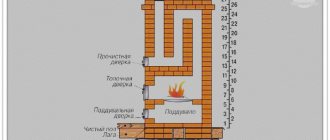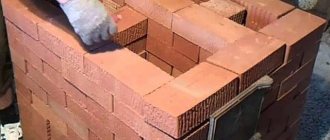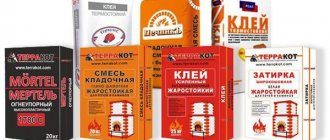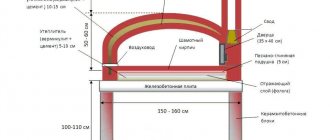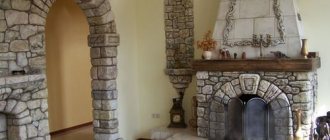Repair and decoration
05/27/2018 Anastasia Prozheva
Covering stoves and fireplaces with tiles is an ancient tradition that is gradually gaining lost ground. Not only Russian, Ukrainian and Belarusian, but also foreign manufacturers of tiles entered the market. Old recipes are being revived and new ones are being created.
However, making tiles is still a very labor-intensive process, most of which is done by the hands of a craftsman. That is why each fireplace and stove tile is a unique piece. As a single product, it has a high cost, which discourages most domestic consumers.
DIY tiles for stoves and fireplaces
How to make tiles with your own hands
A master class on making tiles will be of interest to those who decided to take on the task on their own. The work is not difficult, but painstaking and very exciting. Knowing the nuances of each operation will help you avoid disappointment and get a quality product.
Preparation for work includes: purchasing gypsum putty for making a mold and special clay for the product. Equipment you will need are knives or stacks and a muffle furnace for firing. Step-by-step instructions that will allow you to make a tile in accordance with the traditions of Russian craftsmen will not be superfluous.
Types of tiles
Stove tiles may vary in appearance. In this regard, tiles are classified into:
- plain smooth;
- plain embossed;
- painted smooth;
- painted relief;
- molded.
All these varieties are very beautiful and are considered perhaps the highest quality type of ceramics. Various kinds of patterns and entire paintings with a clearly defined storyline - this is how stoves and walls can be decorated using a material such as tile. You can see photos of structures decorated with it on the page. Nowadays, interest in this type of finishing has increased greatly. And therefore, workshops began to be created, specializing in the manufacture of just such cladding for stoves and walls. Most often they sell standard types of such tiles. However, if desired, you can also order an exclusive kit designed for a specific stove or interior.
Austrian tiled stoves
Hohensalzburg, an ancient fortress on top of the Festungsberg hill in the city of Salzburg, built in 1077 by Archbishop Gebhard, is one of the largest medieval castles in Europe. Since then, the fortress has been rebuilt several times, so today only the foundation remains of the Gebhard building. Despite the powerful walls and impressive appearance of the castle, it always surrendered to the enemy without a fight.
In its entire history, the castle was besieged only once, and even then it was about an armed uprising of peasants in 1525, and frightened feudal lords were holed up in it. Now the castle has the largest collection of exhibits of the military history of Austria and one of the largest collections of military weapons from different historical eras.
Ceramic oven at the Innsbruck Craft Museum
In the Hohensalzburg fortress, two of the oldest tiled stoves in Europe from the 16th century have been preserved. These stoves are of medieval Gothic art and are lined with ceramic tiles coated with lead glazes. The tiles preserve beautiful sculptural images of religious scenes (“The Expulsion of Hagar” from the Old Testament), the twelve apostles and reigning persons.
Historical tiles found during excavations of the Lower Castle
Another masterpiece of Viennese architecture is the Kinski Palace in Vienna. It is interesting not only because it is an unusually beautiful building in the Baroque style, but also because it is a fully functioning building. It hosts art auctions as well as social and diplomatic events. For example, it was there that the EU negotiated the status of Kosovo.
Lower Castle in Vilnius
The palace was commissioned by Count Wirich Philipp von Daun and its construction began in 1717 under the direction of the architect Johann Lucas von Hildebrandt. In 1784, the palace was sold to Count Franz Joseph Kinski, director of the Vienna Military Academy and author of many works on military science. The palace is often called Daun-Kinski after the names of its famous owners. The palace belongs to the Baroque style, has numerous works of art in its interiors, and the facade and its decorative elements set the style for the whole of Vienna until the 19th century.
Historical tiles found during excavations of the Lower Castle
A remarkable tiled stove from 1740 has been preserved in the Kinski Palace. This stove is a typical representative of Viennese stoves of the 18th century; it has landscape and genre painting panels, numerous relief friezes and, of course, sculptural “legs” in the form of lions.
Reconstructed 16th century tiled stoves in the Lower Castle
Crafts Museum in Innsbruck. In 1888, in the face of advancing industrialization and in the wake of the Arts & Crafts movement, Tyrolean artisans decided to open a museum of folk arts and crafts. By 1903, the museum was opened in the building of a former Franciscan monastery in Innsbruck. The museum's collection included beautiful examples of applied art belonging to a wide range of social strata. Here you can find things from peasant life, religious objects, and exquisite art objects from the homes of the Tyrolean nobles and bourgeoisie.
We present to your attention an elegant ceramic stove from the Innsbruck Museum of Applied Arts. This is a cobalt tiled stove in the Renaissance style with white faience bas-reliefs.
Features of the design and installation of tiles
So, we found out what a tile is. This is the name for facing material made from clay. Next, let's look at the installation features of this type of finish. Cladding with this material is done in a completely different way than with tiles. Most often, tiles are used for finishing stoves. If you simply plant them on mortar or glue, they will soon fall off due to exposure to high temperatures during combustion. Concrete mixture is not used for the same reason, even when laying stoves. It is replaced with a clay solution.
The installation of tiles is not carried out on a finished stove, but immediately - already during the process of laying it. When making tiles, holes are drilled in opposite height sections of the rump into which a metal rod is inserted. Next, the box is filled from the reverse side with clay mortar, into which small brick crushed stone is pressed. When laying a stove in this solution, a hole is selected up to the metal rod. Then a wire is overlapped around it, the ends of which are laid between the bricks during the laying process. Traditionally, no seams are left between the tiles. The result is a beautiful yet very durable finish.
Preparing clay
In addition to the fact that you will need special pottery clay (plate), it must be properly prepared. To begin with, the raw materials are divided into small pieces, from which you need to roll into balls. The size of the fractions should be approximately the same as large expanded clay used to insulate floors. Please note that the finer the fraction, the faster the clay will dry.
You need to use pottery clay.
The balls need to be dried naturally (in the sun or just in a warm place). This process is quite long and will take several days. During this time, you will have time to prepare the form, which we will talk about a little later.
When the balls are dry, they should be crushed into dust and sifted. The main goal is to get rid of debris, only clay should remain. It is extremely important that the resulting flour is absolutely clean. During operation of the stove, the tiles will heat up. At the same time, they increase slightly in volume - this is called volumetric expansion. If there are any sticks or pebbles in the clay, then due to the difference in expansion coefficients, the finish may crack.
To insulate the ceiling with mineral wool, you need to use a vapor barrier film.
At the last stage, the resulting powder is poured with water in a ratio of 1:10 and mixed thoroughly. After the clay settles and the water is no longer cloudy, the liquid is drained. The remaining mass is left until the moisture evaporates and the clay reaches the desired consistency. To prevent a crust from forming on the surface, stir from time to time.
German tiled stoves
Germany is a country of talented artisans, so it is not surprising that the most interesting antique stoves were made by German craftsmen.
Tiled stove at Heidelberg Castle
The 16th century was the heyday of the European Renaissance. The world of the “dark” Middle Ages was broken. People perked up, gained wealth and new self-confidence. This is a period of euphoria of the human spirit, which gave a lot for the development of European civilization in all areas of human activity.
The outstanding and most famous ceramicist of the Renaissance in Germany was Hans Kraut.
Rock earthenware oven from the Stockelsdorf factory in Lübeck
Johann Bartholomew Kraut (1532-1596), more often called Hans Kraut, was a potter from southern Germany, also known abroad. Creator of numerous ceramic products at the Austrian court. His most famous surviving work is a tiled relief stove from 1577, kept in the Victoria and Albert Museum.
Tiled stove at Heidelberg Castle
Hans Kraut is rightfully considered one of the most important ceramicists of southern Germany, for he was one of the first to bring Italian majolica across the Alps. He created many pieces new to Germany in the Italian Renaissance style, using drawings by Holbein and Raphael, although his main interest was in sculpture.
Tiled stoves at the Kiln and Ceramics Museum in Velten
Kraut made significant contributions to the decorative arts of Germany, using sculpture and bas-relief in his ceramics. His skill was so great that at the court of Archduke Ferdinand the Second he was accused of witchcraft, and as a result he was even buried outside the Christian cemetery. Two of his sons became followers of their distinguished father, and the name Kraut was famous among potters until the 18th century.
Museum of Kilns and Ceramics in Velten
German artisans have always been receptive to new trends in technology and pedantic in their implementation. The Germans were so successful in the production of stoves that over the centuries, molds for the production of ceramics were purchased from them by many European manufacturers of stove tiles and tiles. This is probably why the largest collection of various tiled stoves can be found in Germany, where applied art keeps pace with architecture, repeating all the main trends in art: from Gothic through the Renaissance to Baroque, Biedermeier and Art Nouveau.
Tiled stoves at the Kiln and Ceramics Museum in Velten
The heyday of German tile art occurred in the 17th-18th centuries. The tiled stoves at Hohenaschau Castle in Bavaria, Heidelberg Castle in Baden-Württenberg and many other castles in Germany date back to this period.
It is impossible not to mention the beautiful rock stoves made at the Stockelsdorf earthenware factory in Lübeck under the leadership of another famous German ceramist, Johann Buchenwald.
Tiled stoves at the Kiln and Ceramics Museum in Velten
Johann Georg Ludwig Boniface Buchenwald (1723–1806), an artist and director of several earthenware factories in Schleswig-Holstein, is one of the most important German ceramic artists.
Under the artistic leadership of Johann Buchenwald, German faience became one of the best in Europe, including in terms of its historical and artistic value.
Potbelly stove with Art Nouveau tiles in the museum in Velten
Another manufacturer of tiled stoves in Germany is the Meissen manufactory, which gave rise to the enterprise of Karl and Ernst Teichert, which produced tiled fireplaces and stoves until the mid-20th century. Noteworthy is the tiled wall produced by the Meissen manufactory, which still exists in Dresden.
But the most extensive collection of German ceramic tile stoves is collected in the stove museum in Velten. Such a large exhibition of stoves from all eras and styles, collected in one place, is probably not found anywhere else in the world.
Here are ancient Gothic tiled stoves, extraordinary Renaissance stoves, wonderful miniature Baroque stoves, intricately curved Rococo stoves and, of course, amazing Art Nouveau stoves.
Empire style tiled stove in the Kiln and Ceramics Museum in Velten
In one article it is absolutely impossible to describe all European tile and stove art - an entire book could be devoted to this. But we hope that we managed to interest you and perhaps you will take the time to visit the places we mentioned and especially the Kiln and Ceramics Museum in Velten.
Museum address
:
Ofen- und Keramikmuseum Velten
Wilhelmstraße, 32
16727 Velten
Telefon: 03304 / 3 17 60
Fax: 03304 / 50 58 87
- russian-mayolica.ru

